Votre page de connexion WordPress n’arrête pas de s’actualiser et d’être connectée lorsque vous essayez de vous connecter à votre site ?
Ce problème vous empêche d’accéder à la zone d’administration de WordPress, ce qui vous empêche de travailler sur votre site.
Dans cet article, nous allons vous afficher comment corriger le problème d’actualisation et de redirection de la page de connexion de WordPress.
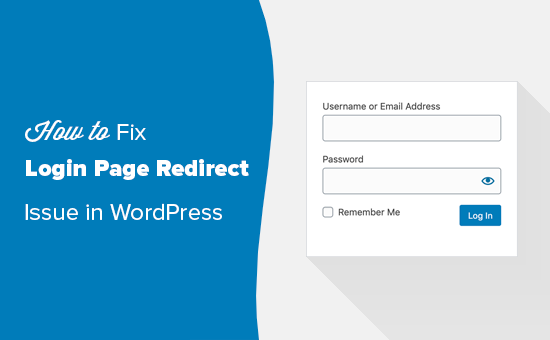
Quelle est la cause du problème d’actualisation de la page de connexion et de redirection dans WordPress ?
L’erreur d’actualisation et de redirection de la page de connexion de WordPress est généralement due à des réglages incorrects de l’URL de WordPress ou au fait que les cookies de connexion n’ont pas été définis.
Normalement, lorsque vous vous connectez, WordPress valide votre nom d’utilisateur et votre mot de passe, puis définit un cookie de connexion dans votre navigateur. Ensuite, il vous redirige vers le Tableau de bord WordPress.
Si WordPress ne définit pas correctement le cookie de connexion ou si l’URL de votre zone d’administration WordPress est incorrecte, vous serez redirigé vers l’écran de connexion au lieu du tableau de bord.
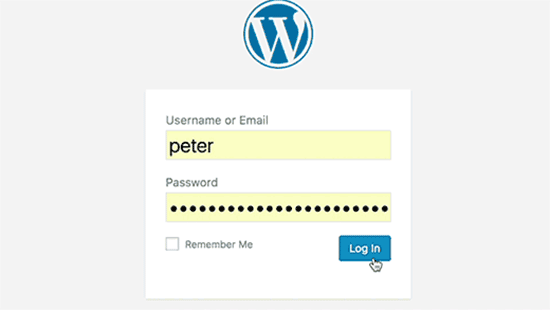
Les problèmes de connexion peuvent également être causés par différentes erreurs de WordPress, telles que l’erreur d’établissement de la connexion à la base de données, l’erreur interne du serveur ou l’écran blanc de la mort.
Avec cela à l’esprit, nous allons dépanner et corriger le problème de redirection et d’actualisation de la page de connexion de WordPress. Vous pouvez utiliser ces liens rapides pour passer à une méthode spécifique :
Note : Si vous voulez essayer les étapes avancées de ce tutoriel WordPress, Veuillez d’abord créer une sauvegarde de votre site. Consultez notre guide sur la création manuelle d’une sauvegarde de la base de données de WordPress.
Tutoriel vidéo
Si vous n’aimez pas la vidéo ou si vous préférez la version écrite, veuillez poursuivre votre lecture.
Méthode 1 : Effacer les cookies pour résoudre les problèmes de connexion
WordPress utilise des cookies pour l’authentification de la connexion, de sorte que la première étape du dépannage des problèmes de connexion à WordPress est la plus simple. Vous devrez effacer les cookies et la mise en cache de votre navigateur.
Dans Google Chrome, il suffit de cliquer sur le menu des Réglages du navigateur, puis de sélectionner Plus d’outils » Effacer les données de navigation.
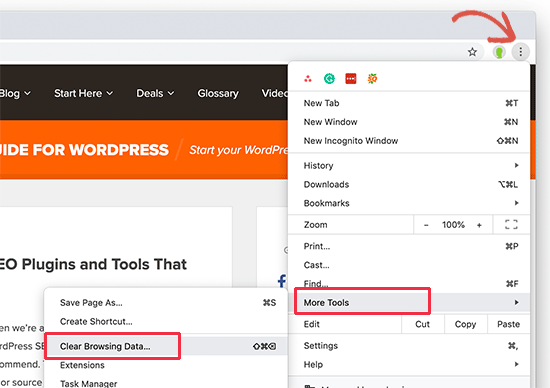
La page Réglages de Chrome s’ouvre et une fenêtre surgissante « Effacer les données de navigation » s’affiche à l’écran.
À partir de là, vous devez sélectionner les options « Effacer les cookies et autres données de site » et « Images et fichiers mis en cache ».
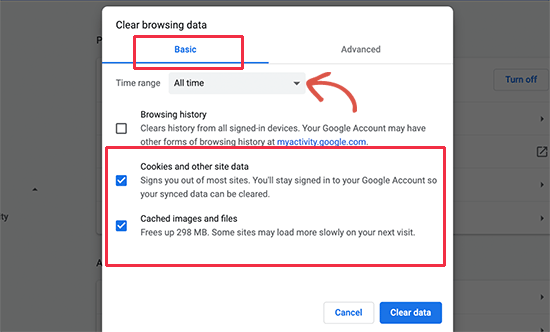
Ensuite, cliquez sur le bouton » Effacer les données « , et Google Chrome effacera la mise en cache du navigateur.
Confirmez également que les cookies sont activés dans votre navigateur. Redémarrez ensuite votre navigateur et essayez de vous connecter. Cela devrait corriger le problème pour la plupart des gens.
Nous avons un guide terminé avec des captures d’écran affichant comment vider le cache et les cookies dans les principaux navigateurs.
Méthode 2 : Mettre à jour les réglages de l’URL de WordPress
WordPress est livré avec des réglages pour l’URL de votre site et l’URL de votre installation WordPress.
Si vous avez accès à la zone d’administration de WordPress, vous pouvez voir cette option sur la page Réglages » Général.
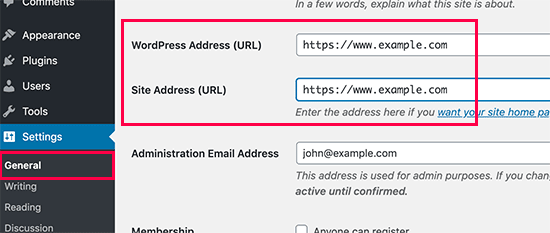
Si ces URL sont incorrectes, WordPress vous redirigera vers la page de connexion.
Comme vous ne pouvez pas accéder à la zone d’administration de WordPress, vous devrez modifier le fichier wp-config.php pour corriger ce problème.
Le fichier wp-config.php est un fichier spécial de WordPress qui contient vos réglages WordPress importants. Vous pouvez y accéder à l’aide d’un client FTP ou via l’application Gestionnaire de fichiers dans le tableau de bord de votre compte d’hébergement WordPress.
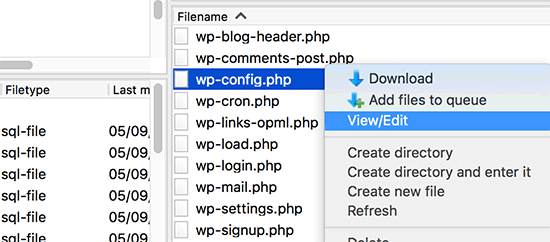
Vous trouverez le fichier wp-config.php dans le dossier racine de votre site. Il vous suffit de modifier ce fichier et de coller les lignes de code suivantes juste avant celle qui dit : "C'est tout, arrêtez les modifications ! Bonne publication".
define('WP_HOME','https://www.example.com');
define('WP_SITEURL','https://www.example.com');
N’oubliez pas de remplacer « exemple.com » par votre propre nom de domaine.
Ensuite, enregistrez vos modifications et téléversez le fichier sur votre site.
Vous pouvez maintenant visiter votre site WordPress et essayer de vous connecter. Corrigé, cela aura corrigé le problème pour vous. Si ce n’est pas le cas, continuez à lire pour connaître les étapes de dépannage supplémentaires.
Méthode 3 : Supprimer le fichier .htaccess dans WordPress
Il arrive que le fichier .htaccess soit corrompu, ce qui peut entraîner des erreurs internes du serveur ou une erreur d’actualisation de la page de connexion.
Il suffit d’accéder à votre site à l’aide d’un client FTP ou via l’app Gestionnaire de fichiers du tableau de bord de votre fournisseur d’hébergement.
Une fois connecté, localisez le fichier .htaccess dans le répertoire racine de votre site et téléchargez-le sur votre ordinateur à titre de sauvegarde.
Si vous ne trouvez pas votre fichier .htaccess, ce guide sur les raisons pour lesquelles votre fichier .htaccess peut être manquant peut vous aider.
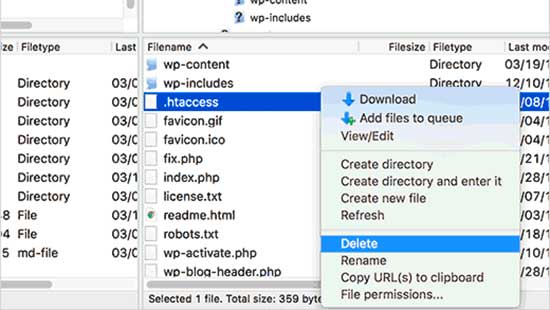
Ensuite, allez-y et supprimez le fichier .htaccess de votre site.
Ensuite, ouvrez le répertoire wp-admin, et s’il y a un fichier .htaccess, allez-y et supprimez-le également.
Vous pouvez maintenant essayer de vous connecter à votre site WordPress. Si vous y parvenez, cela signifie que votre fichier .htaccess vous empêchait de vous connecter à WordPress.
Une fois que vous êtes connecté, il vous suffit d’aller sur la page Réglages » Permaliens dans le panneau d’administration de WordPress et de cliquer sur le bouton » Enregistrer » sans faire aucune modification. Cela générera un nouveau fichier .htaccess pour votre site.
Méthode 4 : Désactiver toutes les extensions WordPress
Parfois, les extensions WordPress peuvent être à l’origine de ce problème, notamment en cas de conflit entre deux extensions.
Pour désactiver facilement toutes vos extensions WordPress, connectez-vous à votre site à l’aide d’un client FTP ou via l’appli Gestionnaire de fichiers du tableau de bord de votre compte hébergeur.
Une fois connecté, rendez-vous dans le répertoire /wp-content/. À l’intérieur de celui-ci, vous verrez un dossier nommé » plugins « . C’est dans ce dossier que WordPress installe toutes vos extensions.
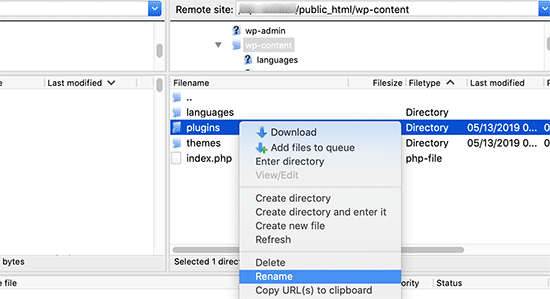
Il suffit de renommer le dossier des extensions en « plugins_backup ». Cela désactivera toutes les extensions WordPress installées sur votre site.
Nous avons également un tutoriel détaillé sur la façon de désactiver toutes les extensions WordPress lorsque l’administrateur WordPress est inaccessible.
Une fois que vous avez désactivé toutes les extensions, essayez de vous connecter à votre site WordPress. Si vous y parvenez, cela signifie qu’une de vos extensions était à l’origine du problème.
Méthode 5 : Revenir au thème par défaut
Les thèmes WordPress peuvent également provoquer des conflits après avoir mis à niveau vers une version plus récente de WordPress ou du thème lui-même. Pour trouver si le problème est causé par votre thème, vous devrez le désactiver.
Le processus est similaire à celui de la désactivation des extensions. Connectez-vous à votre site à l’aide d’un client FTP. Ensuite, vous devez vous rendre dans le répertoire /wp-content/themes/ et renommer votre répertoire de thème actuel en » themes_backup « .
Une fois que vous avez fait cela, essayez de vous connecter à nouveau. Si vous y parvenez, cela signifie que c’est votre thème qui est à l’origine du problème.
Vous pouvez maintenant réinstaller une nouvelle copie de votre thème pour voir si cela résout le problème. Si le problème réapparaît, vous devrez alors contacter le support de votre thème ou changer de thème WordPress.
Méthode 6 : Réinstaller le cœur de WordPress
Dans de rares cas, le problème d’actualisation persistante de la page de connexion peut être causé par des fichiers du cœur de WordPress corrompus.
Ces fichiers cœurs constituent la base de votre site WordPress et gèrent des fonctionnalités essentielles. Si ces fichiers sont endommagés ou écrasés par du code incorrect, cela peut prospecter diverses erreurs, notamment des problèmes de connexion.
Tout d’abord, rendez-vous sur le site WordPress.org et téléchargez la dernière version du logiciel. Une fois téléchargé, décompressez le fichier sur votre ordinateur. Cela créera un dossier nommé « WordPress » contenant tous les fichiers nécessaires à la réinstallation.
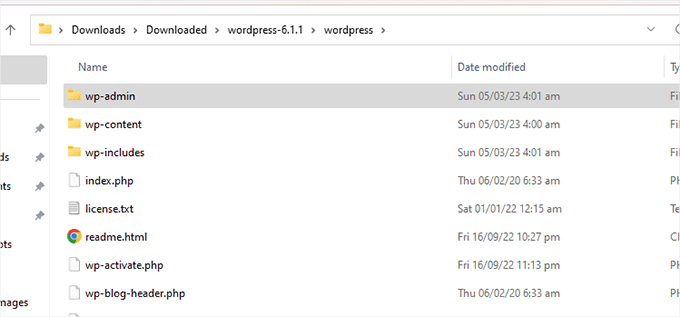
Ensuite, vous devez vous connecter à votre site à l’aide d’un client FTP ou du gestionnaire de fichiers fourni par votre entreprise d’hébergement.
Une fois connecté, naviguez jusqu’au dossier racine de votre site. Il s’agit du répertoire principal qui contient des dossiers tels que wp-admin, wp-content et wp-includes.
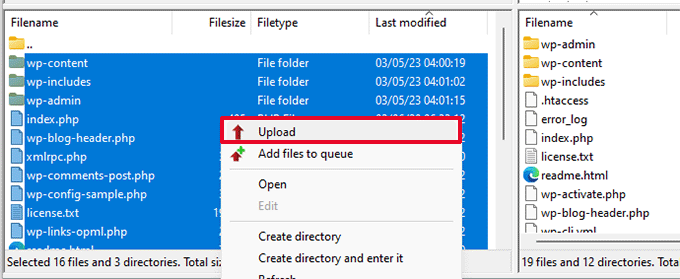
À ce stade, récupérez tous les fichiers du dossier « wordpress » sur votre ordinateur et téléversez-les dans le répertoire racine de votre site.
Votre client FTP vous demandera de confirmer l’écrasement de tout fichier cœur existant.
Puisque vous supprimez les fichiers corrompus du cœur de WordPress et que vous les remplacez par de nouveaux, choisissez « Écraser » et sélectionnez l’option « Toujours utiliser cette action » pour éviter d’avoir à confirmer chaque fichier individuellement.
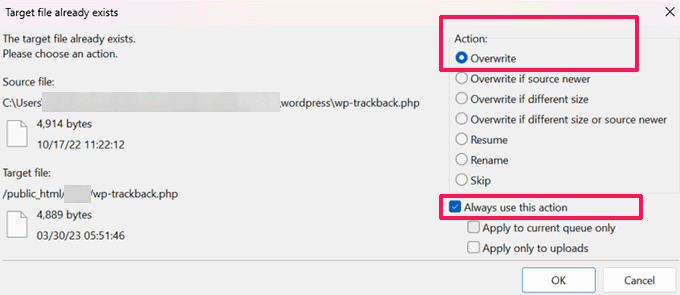
Enfin, cliquez sur « OK » pour lancer l’outil de téléversement. Votre client FTP remplacera les fichiers WordPress du cœur de votre site par les nouveaux fichiers de votre ordinateur.
Une fois le téléversement terminé, visitez votre site pour voir si l’erreur est corrigée. Si le problème de connexion est dû à un fichier cœur corrompu ou à un logiciel malveillant, le message d’erreur devrait avoir disparu et vous devriez pouvoir vous connecter bien.
En savoir plus sur les solutions de dépannage de WordPress
Vous rencontrez d’autres erreurs courantes sur WordPress et vous devez trouver un moyen de les corriger ? Voici d’autres articles que vous pouvez consulter :
- Comment corriger l’erreur « trop de redirections » sur WordPress ?
- Comment corriger facilement l’erreur « This Site Can’t Be Reached » (Ce site n’est pas accessible) sur WordPress
- Comment Corrigé ‘The Site Is Experiencing Technical Difficulties’ dans WordPress
- Comment corriger l’erreur 404 dans les publications WordPress (étape par étape)
- Comment corriger l’erreur de contenu mixte dans WordPress (étape par étape)
- Comment corriger l’erreur JSON non valide dans WordPress (Guide du débutant)
- Comment trouver et accéder aux journaux des erreurs de WordPress (étape par étape)
- Comment Corrigé WordPress ne pas envoyer des e-mails
Nous espérons que cet article vous a aidé à résoudre le problème d’actualisation et de redirection de la page de connexion de WordPress. Vous pouvez également consulter notre guide complet de dépannage WordPress ou consulter notre top des meilleures extensions et outils WordPress pour développer votre site.
Si vous avez aimé cet article, veuillez alors vous abonner à notre chaîne YouTube pour obtenir des tutoriels vidéo sur WordPress. Vous pouvez également nous trouver sur Twitter et Facebook.




Syed Balkhi says
Hey WPBeginner readers,
Did you know you can win exciting prizes by commenting on WPBeginner?
Every month, our top blog commenters will win HUGE rewards, including premium WordPress plugin licenses and cash prizes.
You can get more details about the contest from here.
Start sharing your thoughts below to stand a chance to win!
Warren Ganye says
I first cleared the cache and cookies. Initially it didn’t work, i couldnt stop the log in loop. This was because i had redirected the url to a sub directory using .htaccess.
I then had to delete the .htaccess file i had updated and created a new copy of it.
After that i was able to log in my wp-admin. Then i went to settings to customise the permalinks settings tag base to the name of the subdirectory i had placed the wordpress installation so that my other pages besides the home page could work. Hope it helps
Hope it helps
Gavin says
I’m able to log into WP Admin and then go to visit site and edit and browse from there on Internet Explorer. However on both google chrome and Safari, when I hit « Visit Site » it just takes me back to the admin login page again.. and again etc. I’ve tried everything and I’m just not understanding why it’s letting me get on with life in Internet Explorer but not Google Chrome/Safari. If someone replies to this, thanks for thought and time in advance!
Andy V says
Gavin —
Exactly problem i am having. What did you do to resolve it?
Thanks,
Andy
Gilles says
Hi,
On my side, the limitation came from a MySQL limitation of 100 Mb in my formula (which I did not know). After having reduced it, I could have access again to WP-admin.
Titus Raj says
All above did not work for me.
I migrated from 5.6 php to 5.4php hosting
I then changed the new hosting to 5.6php then did migrate again, it worked.
Shahkar says
Hi. I tested every things but not worked for me.
I wanted to create a backup from DirectAdmin but it appears an error in between backing up. It says the wp_usermeta is crashed and repair is not helpful for it.
So I opened the SSH and after login to server, I writed:
cd /var/lib/mysql/[DATABASE NAME]
and then:
myisamchk -r -v -f wp_usermeta
So this table is fixed and my users can login after this.
If you haven’t access to SSH you should contact your hosting support.
I hope it will be useful
Ather says
Hey there! I have an active theme named ‘church’ in which i’m customizing a website. When i install plugins and make changes over the website, it works pretty fine. but then when i logout to my wordpress account, the changes made are reverted back. Please help me out!
Thanks in advance
Kingsley says
After entering my login details, wp will reload and it wont redirect me to my dashboard. I then read through your guidelines. I tried everything and it was not working for me. The worst is that when I got to the step of delete htaccess, i did it and i started receiving 404 Not Found error on my login page. Please assist
Jason says
One-man-show, do it yourself-er here… non computer wiz, banging my head against the wall for 4 days trying to fix this problem. Tried everything on this list, messed with my .htaccess and wp-config files a hundred different ways (which deleting all the .htaccess files worked for a second, until I resaved by permalink settings). . Also of importance was that I had used been using cloudflare for CDN purposes. Lastly, my problems coincided with switching hosting. So after trying everything here and about 1.5 hours on the phone with tech support at my hosting, it ended up being that I had a conflict with the www CNAME record. I serve my site as www and apparently the CNAME record with my new (actually original) host was still pointing at cloud flare. I « paused » my site with cloud flare, and updated the www CNAME record in my web host’s cPanel’s Advanced DNS Zone Editor by removing the (mynamerserver.cloudflare) from the end of themysite.mynameserver.cloudflare.com. Now the www CNAME is simply named mysite.com. Viola! Logged back in and all is good. Phew! On to the next fire, which is now that some of my navigation links on my site are 404-ing…but that’s for another thread. Thanks for this page and the active nature of this site, has already helped me fix/learn a ton.
Cheers!
–
WPBeginner Support says
Hey Jason,
Glad you solved it. For 404 errors, check out our guide on how to fix 404 error in WordPress.
Administrateur
Craig Hodge says
I have read through the entire article, and every single comment, tried every idea that has been suggested, and about a dozen others, and nothing works. I am still unable to log in to wp-admin.
Peter Vukovic says
Another possibility is that your disk space is full. WordPress login will fail silently if this is the case.
Vinny O'Hare says
I had this issue and instead of going the ftp route I logged into my managewp account and logged in and resaved the permalinks and I was good to go.
Baggy says
I found that the file permissions were not correct (group had write access).
stephen miller says
Since installing SSL 10 days ago we’re unable to log in to the WordPress blog (all the WP files sit in that directory). The login credentials are accepted but the login page redirects back to itself with fields empty, We’ve tried everything- including everything mentioned in this article:
(Below the last of recommended fixes. The ‘x’ means they were tried to no effect)
x Clear Cookies to Resolve Login Issues
x Deactivate All Plugins
(x*) Revert Back to the Default Theme (there was no problem following a theme change 2 months ago)
x Delete .htaccess File
x Update Site URL (add these to wp-config.php)
define(‘WP_HOME’,’http://example.com’);
define(‘WP_SITEURL’,’http://example.com’);
(Did those with no effect)
We’re at our wits end with this. Would really appreciate some help. Remember we can only access the ftp files, not the WP admin area.
If nothing else, can we make a new blog and transfer several years of critical posts to the new one? Or do a re-install of WP via FTP? Please help!
WPBeginner Support says
Hi Stephen,
After successfully installing SSL, your WordPress site should be using https instead of http. Please try adding these lines to wp-config.php file
define('WP_HOME','https://example.com'); define('WP_SITEURL','https://example.com');1-click Use in WordPress
Administrateur
vishal says
after clicking the lost password in wordpress based my website still i am stuck over in the same page please help me with the same
Pat Parker says
I increased the memory in wp-config and that worked.
define(‘WP_MEMORY_LIMIT’, ‘512M’);
andy says
didn’t work fpr me
Connor G says
Hi,
I have the same issue you outline in this post, however I’m also getting a « This site is not Secure » flag from Google which I was able to bypass through the ‘Advanced Options’ under the warning. I’ve tried all of the above with no luck. Even adjusting my website url in the PHPmyadmin tool hasn’t stopped me from being redirected.
Is there something else that has gone wrong here further than what you describe above, or is the Google security warning common with this issue?
Thanks a ton!
Lena says
Hello there, I tried every trick and my wp-admin page still tell me « Sorry, you are not allowed to access this page. » I try loging in through wp-login.php and I see a login page but it redirects me to our homepage. I tried deactivating plugins, themes, and unblocking my IP through wp-config.php with no luck. Any tips would be greatly appreciated! Thanks!
ATRYNA says
We have same problem, but after a few minutes and keep trying to loging I can access my wp-admin and the dashboard running normally agan.
Janice Roth says
Hi WordPress experts,
Would really appreciate a voice to calm my panic. My head is spinning. I am not a web expert, just a person setting up my own business site. My site is set up on WordPress, on a temp URL while I’m still building it. Using RT them 19. Been using it no problem for a while, but now I can’t access the site using my usual user name and password. Keeps saying not valid »
Also, above the log in area there are a whole lot of lines that look like this.
Only 1 looks like this
Warning: ksort() expects parameter 1 to be array, object given in /home/content/html/wp-content/plugins/bbpress/includes/core/template-functions.php on line 316
About 20 lines look like this
Warning: Cannot modify header information – headers already sent by (output started at /home/content/html/wp-content/plugins/bbpress/includes/core/template-functions.php:316) in /home/content/html/wp-login.php on line 394
WPBeginner Support says
Hi Janice,
It seems like your theme or a plugin is causing this issue. Please take a look at our step by step WordPress troubleshooting guide to figure out what’s causing the issue.
Administrateur
barbara says
i can’t log in. wordpress won’t accept my name, my password. won’t allow me to create a new reader account under a different address or name. i am completely locked out and have lost hundreds of feeds. i am NOT a blogger – only a follower, and wordpress seems only interested in bloggers, with little or no support for followers. i have tried changing my password several times and even when brand-new, it will not be accepted. i have called the phone number and have gotten either no answer or a message telling me that the number is no longer in service. i am so frustrated i just want my feeds back so i can export them to someplace else.
Sutapa Chatterjee says
I am not being able to log in at all, how do I even change the URL settings ?
Ryan says
I did the last suggestion where you enter in
define(‘WP_HOME’,’http://example.com’);
define(‘WP_SITEURL’,’http://example.com’);
Took a bit to figure out how to do it but it worked perfectly. Thanks!
(BTW you can just do it through cpanel – file manager – and edit the code.)
Kas says
I solved it by going to the php my admin and wp_users by changing the username to something else (same for nickname etc..) and saved. Logged in again with the new name and same password and it worked.
andy says
didn’t work for me
Nelson Mulama says
I had the same problem on multiple migrated websites and none of the above stated solutions seemed to work.
My problem arises from the fact that each time I do the migration, I create a totally new Word Press users who don’t have any posts or pages assigned to them.
The thing with the wp-login.php (for my case) is it was redirecting me to the homepage as I didn’t have any content assigned to the user.
Solution, went to the wp-posts table and assigned one article to the new user using userID (you will find this in your wp-users table)
solved the problem
David Rawlins says
Thanks very much. For me it was a plugin that messed things up. Now sorted
Angelo Saponaro says
Hi, Can I ask you to come has Solved? Not one of the solutions above me I have helped.
Thank you
Munna Hossain says
It is really a common error of WordPress. I also faced this problem. But now I am Ok. All these options have not Worked. Thanks for sharing.
Angelo Saponaro says
Hi, Can I ask you to come has Solved? Not one of the solutions above me I have helped.
Thank you
peter says
The redirect problem occurred for me after the DNS DDoS attack on Oct 21, 2016.
I found a simple solution by including an admin page in the login path such as:
yourdomain.com/wp-admin/nav-menus.php
Login with this directed right to the menu panel.
After logout, I was able to login normally with just /wp-admin.
Don’t know why, but it worked!
Chris says
Hey Peter, this happens to several of my websites as well. I normally go to wp-admin/theme-editor.php because it won’t let me login through wp-admin. When I click ‘Log In’, it just refreshes the login page.
Chris says
and I’ve tried the options above, it still didn’t solve the issue.
Lynn Spivey says
Thanks Peter!
Thanks so much for posting the link – my computer experience involves FaceBook and Amazon Prime, so I needed someone to tell me to type this and go here! Telling me to paste a code into something that I can’t even figure out how to access wasn’t working for me! I have spent a couple of days trying to log in and was just about to walk away for good! You saved the day, seriously. Hero! (:
Renee Blundon says
THANK YOU! This finally finally finally resolved the login and logout issues with my site. I owe you guys big time!! What did the trick was editing the wp-config file with these two lines:
define(‘WP_HOME’,’http://example.com’);
define(‘WP_SITEURL’,’http://example.com’);
Thanks again, you guys are amazing!
-Renee
Niall Guerin says
You are a superstar. Was really getting frustrated with other tips and guides. I followed your tips, 1 by 1. Nothing worked until the last one using the 2 define statements. In my case, I did a DNS update 72 hours ago. The DNS propagated to most locations within 12-24 hours, but the wp-admin completely failed. I used md5/password update via phpadmin from your other blog tip (also excellently written and illustrated) and was still having no joy so followed this guide as second step. As soon as I did it, the password invalid message then displayed after a test login. Then the password reset link started working also which did not work after all prior error checks. The reset mail was received and worked fine and all stable again. Really really appreciate you putting this together as you just sorted me out big time. Thanks. Niall
WPBeginner Support says
Hey Niall,
Glad you found it helpful Don’t forget to follow us on Facebook for more WordPress tips and tutorials.
Don’t forget to follow us on Facebook for more WordPress tips and tutorials.
Administrateur
Adeolu Adeyemi says
Non of the above solutions worked for me. I had to check the php error log, and I saw this
WordPress database error Duplicate entry ‘0’ for key ‘PRIMARY’ for query INSERT INTO `wp_usermeta` (`user_id`, `meta_key`, `meta_value`) VALUES (4, ‘session_tokens’, ‘a:1:{s:64:\ »235054a04c368610fe278c9aa25e46f411483bbc6b9dd52fa4574b3ba4d5ecac\ »;a:4:{s:10:\ »expiration\ »;i:1476532105;s:2:\ »ip\ »;s:3:\ »::1\ »;s:2:\ »ua\ »;s:109:\ »Mozilla/5.0 (Windows NT 6.3; WOW64) AppleWebKit/537.36 (KHTML, like Gecko) Chrome/52.0.2743.116 Safari/537.36\ »;s:5:\ »login\ »;i:1476359305;}}’) made by wp_signon, wp_set_auth_cookie, WP_Session_Tokens->create, WP_Session_Tokens->update, WP_User_Meta_Session_Tokens->update_session, WP_User_Meta_Session_Tokens->update_sessions, update_user_meta, update_metadata, add_metadata
Querying the database to remove the umeta_id with id 0, did it for me.
Amin says
you are right bro i have same problem too, but i didn’t get how resolve it u.u
Sommie Njoku says
Yup. This did the trick for me!
Go to your database wp_usermeta and change the umeta_id 0 to something else.
Miguel says
Last one worked forme
Thanksss
Dami3n says
I run around 10 websites and never came across this problem until today. I closed my WordPress site by mistakes whilst doing a long edit. Not sure if this was the issue but on opening Firefox again an trying to login to WordPress i kept being redirected. I noticed i still got an error for logging in incorrectly.
I set off to work to try and find a solution. Renamed theme folders plugins got rid of cache. Nothing worked. I decided this has to be a problem with the .htacess file. Now the problem you have is most sites that you go through a cpanel will not show this file. So grab something like filezilla. To find it. I re uploaded the exact same one to the server and it’s all back to normal must have been a brain fart…. just seems odd that exact same file has fixed the problem.
[edit sorry]
Craig says
Great – had this problem for a few days where I sometimes couldn’t log-in, but mostly when I went to view site when I WAS logged in, I’d see the maintenance mode page, as if I wasn’t logged in! Defined the site in WP-Config and problem sorted.
Thanks!
Bhavya says
Hello,
My WordPress Dashboard => Home( Edit Page) still loading what we do?
if i check in view page it shows my website(no errors in this page).
can anyone Please Suggest me.
Richard Taylor says
Deactivating Plugins worked for me … thank you so much
Gareth says
Deleting the .htaccess file solved my issue!
Thanks guys
Ocean says
Defining the site URL worked for me! Thanks a ton!
Tejpal Choudhary says
Last one « update site URL » worked for me .
Thanks from the bottom of the heart.
Dave says
I had this problem when a site was built a long time ago without using wordpress secret-keys in the wp-config.php file.
When I added the secret keys to wp-config.php as part of upgrading the site’s security I was not able to login (even after trying all of the above fixes) and it seemed that the login page was just refreshing instead of bringing me to the wordpress dashboard.
To solve the login-refreshing problem, I temporarily went back to my old wp-config.php file without the secret-keys and was able to log in.
Kjetil says
Last method worked – BUT the Settings > General > WordPress URL and Website URL are greyed out/ impossible to change + if I remove those two lines from wp-config.php the problem returns.
ANY WAY to change the URL settings – and make them remain correct?
Thanks
PS I also tried to edit the database’s options table (and enter the correct site url in the first line there), but no luck.
Kathy Porter says
Chrome > Settings > Advanced > Reset Settings
Chrome finally works like it’s supposed to again! Yay!
Joana Ashford says
Yay this worked for me
Steve says
LAST ONE WORKED! Huzzah!
David says
Ditto!
Debaiss says
Most of the time it is the plugins that creates this problem.
Kathy says
I tried everything, too, and nothing worked. The problem only exists in Chrome for me.
Kathy says
Finally it’s fixed! I reset Chrome.
Julio Fermin says
I trying everything and don’t work permanently. What I can do? I am using hostinger and a godaddy domain.
Sagun Khadka says
The last method worked for me Thanks
Thanks
Kingsley Iyke says
Regarding wp-admin login not coming up, I have done all of the above suggestions but non could fix the problem. Can anyone help with new solution. I`ll appreciate. Kingsley Iyke
Van Hallman says
I fixed my issue by removing the top 2 lines in my wpconfig.php which were referencing a non existent W# Total cache install.
Janice says
Excellent tutorial. Easy to figure out and best of all, following the instructions enabled me to solve my problem quickly!
Turns out a plug-in was the culprit so by renaming the plugin folder I was able to deactivate them all and sign in. (Good thing to know for the future.) I then added them back one by one to determine which plugin was causing the problem.
One thing … please don’t laugh … you have to double click on the plugin folder name to change it. I was right clicking on it to try to rename it (as you do in Windows file explorer) … minor detail I forgot about.
Joni says
Any tips if none of these work? Only have the redirect issue when trying to login to Admin. Site seems fine for viewing for everyone. Just the login issue to Dashboard.
Georg says
Jepp, the same problem like before… I’ve tried all the tricks, but nothing works…
Please help…
All the other sites with the same WP version still running best – also the login. Only one of the sites (at another provider) doesn’t work (only the login, I mean).
Sorry for my poor english…
All the best
Georg
Georg says
Hello,
I’ve found the problem: One or more of three of my plugins caused an data-overflow of one of the fields in the database.
I’ve installed the problematic plugins:
– Simple login log
– Limit Login Attempts
– Rich Counter
The database has a total limit of 1024MB… but it used 1288MB and this caused the problem.
After erasing the content of the database-fields of all of the three plugins and reconfiguring the settings of them, the login was functioning till today…
Best Regards
Georg
Kingsley says
Now of this works……. i suspect the database because when comparing it to default wp install AUTO_INCREMENT is missing from the « extra » column on my database
Kingsley says
i mean NON work for me
Phoenix says
Clearing the cache and cookies helped me. Thank you